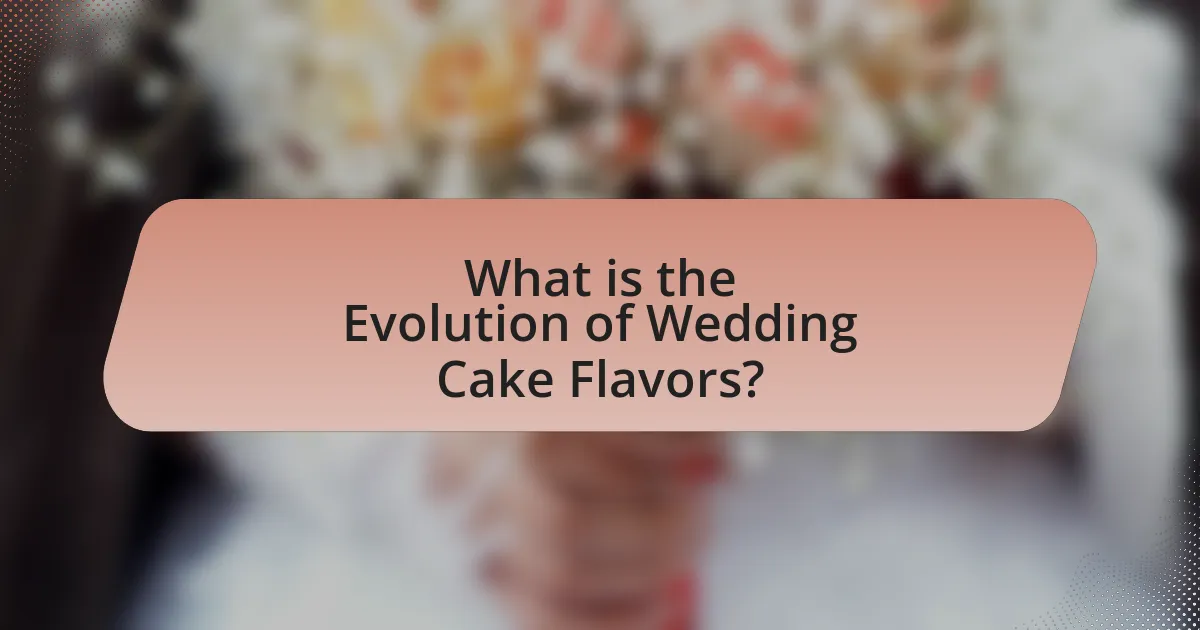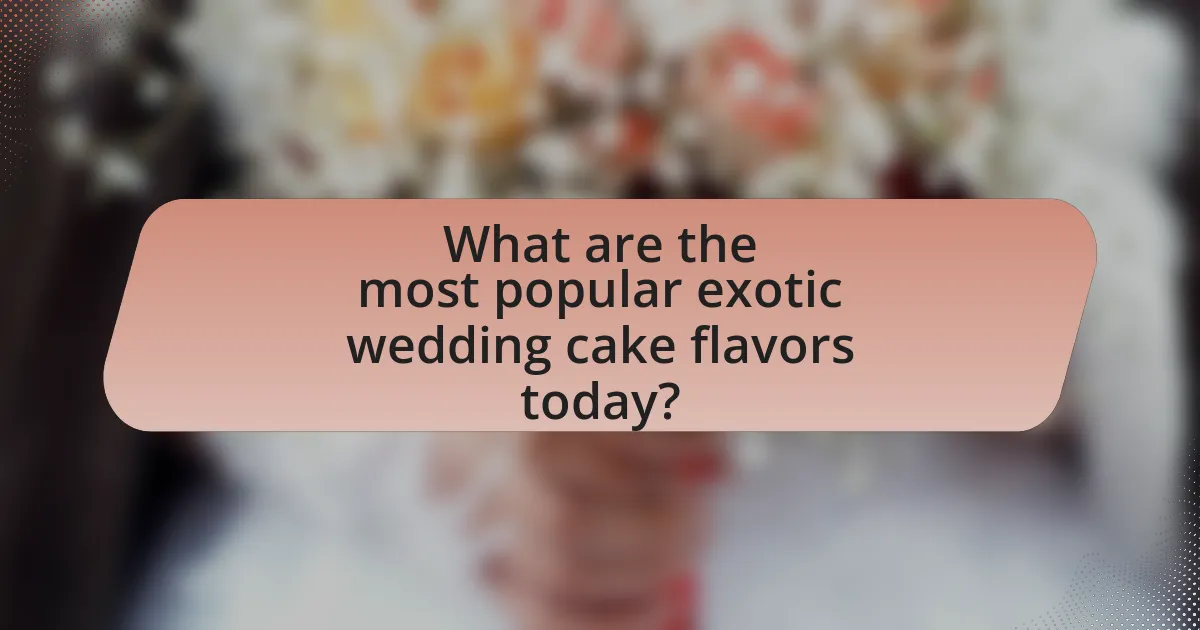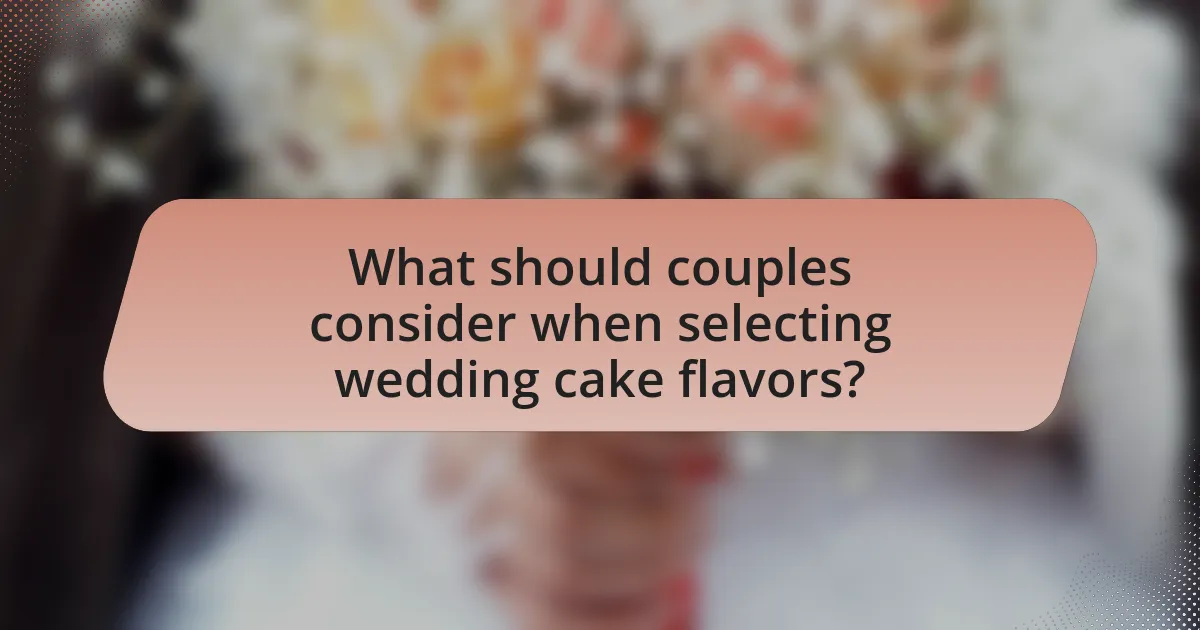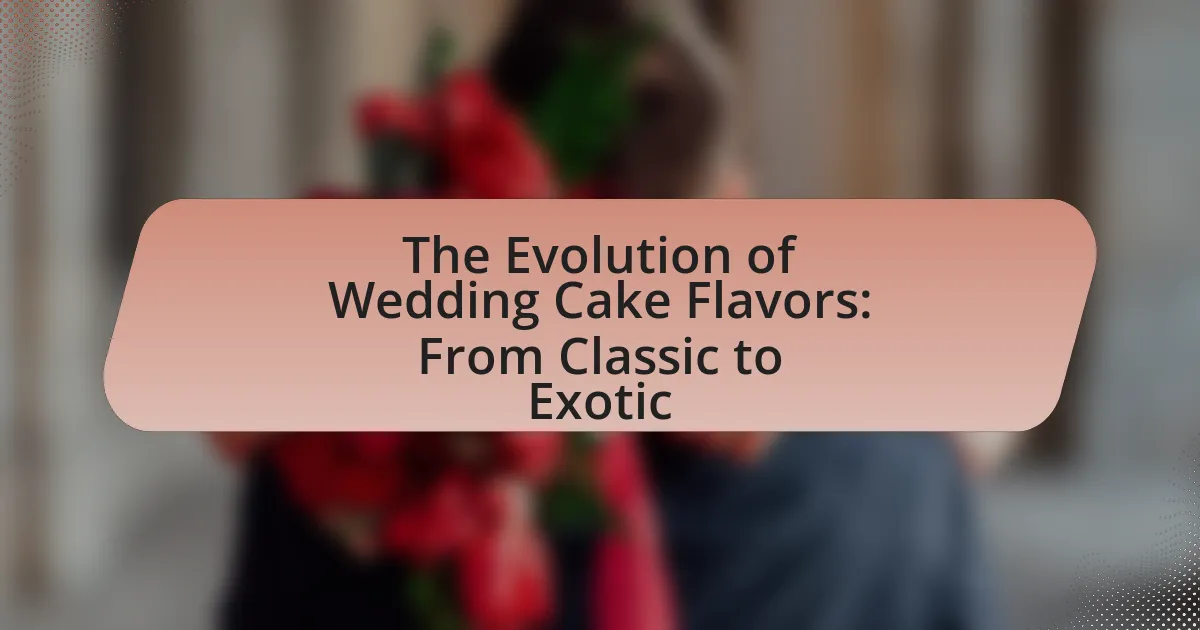The article examines the evolution of wedding cake flavors, highlighting the transition from traditional options like fruitcake and vanilla to a diverse range of innovative and exotic choices. It explores historical influences on flavor preferences, the impact of cultural traditions, and the rise of artisanal bakeries and social media in shaping modern tastes. Key trends include the incorporation of unique flavors such as matcha and lavender, as well as dietary considerations that influence flavor selections. The article also discusses best practices for flavor pairings and common mistakes couples should avoid when choosing their wedding cake flavors.

What is the Evolution of Wedding Cake Flavors?
The evolution of wedding cake flavors has transitioned from traditional options to a diverse array of innovative choices. Historically, wedding cakes were primarily fruitcakes, symbolizing prosperity and fertility, with flavors like almond and lemon being popular in the 19th century. As culinary trends evolved, the late 20th century saw the introduction of lighter cakes, such as vanilla and chocolate, reflecting changing tastes. In recent years, couples have embraced exotic flavors like lavender, matcha, and even savory options, showcasing a shift towards personalization and creativity in wedding celebrations. This trend is supported by the rise of artisanal bakeries and social media, which have influenced flavor experimentation and customization in wedding cakes.
How have wedding cake flavors changed over time?
Wedding cake flavors have evolved from traditional options like vanilla and chocolate to a diverse array of exotic and unique flavors. Historically, wedding cakes were primarily fruitcakes or simple sponge cakes, reflecting the ingredients available and societal norms of the time. In the late 20th century, the introduction of new baking techniques and global culinary influences led to the incorporation of flavors such as lemon, almond, and red velvet. More recently, trends have shifted towards even more adventurous choices, including matcha, lavender, and salted caramel, driven by consumer demand for personalization and unique experiences in celebrations. This shift illustrates a broader trend in the culinary world towards experimentation and flavor diversity, as seen in the rise of gourmet and artisanal baking.
What historical influences shaped early wedding cake flavors?
Early wedding cake flavors were shaped by cultural traditions, availability of ingredients, and social status. In ancient Rome, cakes made of wheat and honey symbolized prosperity and fertility, while medieval England introduced spiced cakes, reflecting the influence of trade routes that brought exotic spices to Europe. The use of fruit and nuts in cakes was common among the wealthy, as these ingredients were more accessible to the affluent. Additionally, the rise of sugar in the 17th century allowed for sweeter cakes, marking a shift in flavor profiles that aligned with the growing popularity of elaborate wedding celebrations.
How did cultural traditions impact flavor choices in wedding cakes?
Cultural traditions significantly influenced flavor choices in wedding cakes by dictating the ingredients and preparation methods used in different regions. For instance, in Western cultures, vanilla and chocolate became popular due to their widespread availability and acceptance, while in Asian cultures, flavors like matcha and red bean are favored, reflecting local tastes and customs. Historical practices, such as the use of fruitcake in British weddings, stem from traditions that symbolize fertility and prosperity, further shaping flavor preferences. These cultural influences are evident in contemporary wedding cakes, where traditional flavors are often blended with modern tastes, showcasing a fusion that honors heritage while embracing innovation.
What are the classic wedding cake flavors?
Classic wedding cake flavors include vanilla, chocolate, and almond. These flavors have been traditional choices for wedding cakes due to their widespread appeal and versatility. Vanilla is often favored for its light and sweet profile, chocolate provides a rich and indulgent taste, and almond adds a subtle nutty flavor that complements various fillings and frostings. Historical preferences for these flavors can be traced back to their availability and popularity in baking, making them staples in wedding celebrations.
Which flavors are considered traditional for wedding cakes?
Traditional flavors for wedding cakes include vanilla, chocolate, and almond. These flavors have been favored for centuries due to their wide appeal and versatility. Vanilla, often considered the classic choice, has a rich history dating back to the 19th century when it became popular in wedding celebrations. Chocolate, another staple, offers a decadent option that complements various fillings and frostings. Almond flavoring, with its distinct nutty taste, has also been a traditional favorite, particularly in European wedding cakes. These flavors are rooted in culinary traditions and continue to be preferred choices for couples today.
How do classic flavors reflect the customs of different eras?
Classic flavors reflect the customs of different eras by embodying the ingredients, techniques, and cultural influences prevalent during those times. For instance, the use of vanilla and almond in wedding cakes during the Victorian era signifies the era’s emphasis on elegance and refinement, while the incorporation of spices like cinnamon and nutmeg in earlier periods reflects the availability of trade goods and the influence of global exploration. Historical records indicate that flavors such as fruitcake became popular in the 19th century, aligning with the customs of celebration and abundance associated with weddings during that time. Thus, classic flavors serve as a culinary timeline, illustrating how societal values, economic conditions, and cultural exchanges shape the tastes and preferences of each era.
What factors contributed to the rise of exotic wedding cake flavors?
The rise of exotic wedding cake flavors is primarily attributed to evolving consumer preferences for unique and personalized experiences. As couples increasingly seek to reflect their individual tastes and cultural backgrounds in their wedding celebrations, they gravitate towards unconventional flavors that stand out from traditional options. This trend is further fueled by the influence of social media, where visually appealing and distinctive cakes gain popularity through platforms like Instagram, encouraging bakers to innovate and experiment with diverse ingredients. Additionally, the globalization of culinary practices has introduced a wider array of flavors and techniques, allowing for the incorporation of international elements into wedding cakes.
How has globalization influenced wedding cake flavor trends?
Globalization has significantly influenced wedding cake flavor trends by introducing diverse cultural flavors and ingredients into mainstream wedding celebrations. As people travel and share culinary traditions, flavors such as matcha from Japan, dulce de leche from Latin America, and chai spices from India have gained popularity in wedding cakes. This shift is supported by data showing that 40% of couples now choose non-traditional flavors, reflecting a broader acceptance of global cuisines in personal celebrations. The rise of social media platforms has further accelerated this trend, allowing couples to discover and share unique flavor combinations from around the world, thus reshaping the traditional wedding cake landscape.
What role do social media and celebrity culture play in flavor innovation?
Social media and celebrity culture significantly drive flavor innovation by amplifying trends and preferences among consumers. Platforms like Instagram and TikTok allow for rapid dissemination of visually appealing food content, which influences public interest in unique and exotic flavors. For instance, celebrity chefs and influencers often showcase innovative flavor combinations, leading to increased demand for these options in wedding cakes. Research indicates that 70% of consumers are influenced by social media when making food choices, highlighting its role in shaping flavor trends. This dynamic interaction between social media, celebrity endorsements, and consumer behavior fosters a continuous evolution of flavor offerings in the wedding cake market.
How do modern couples choose their wedding cake flavors?
Modern couples choose their wedding cake flavors by considering personal preferences, current trends, and guest satisfaction. They often select flavors that reflect their tastes, such as chocolate, vanilla, or more unique options like red velvet or lemon, influenced by popular culture and social media. Additionally, many couples opt for tastings with bakers to sample various flavors, ensuring the final choice appeals to both them and their guests. This approach aligns with the growing trend of customization in weddings, where couples seek to create a memorable experience that resonates with their individual styles and the preferences of their attendees.
What are the current trends in wedding cake flavors?
Current trends in wedding cake flavors include unique combinations such as lavender and lemon, chocolate with raspberry, and salted caramel. These flavors reflect a shift from traditional vanilla and chocolate to more adventurous and sophisticated options. According to a survey by The Knot, 30% of couples in 2023 opted for non-traditional flavors, indicating a growing preference for personalized and distinctive cake experiences. Additionally, the use of natural ingredients and organic flavors is on the rise, aligning with broader consumer trends towards health and sustainability.
How do dietary preferences affect flavor selections?
Dietary preferences significantly influence flavor selections by guiding individuals toward specific ingredients and taste profiles that align with their dietary restrictions or lifestyle choices. For instance, vegetarians may prefer fruit-based or nut-flavored cakes, while those following a gluten-free diet will opt for cakes made with alternative flours, such as almond or coconut flour. Research indicates that consumers are increasingly seeking flavors that reflect their dietary choices, with a 2021 survey showing that 60% of respondents consider dietary restrictions when selecting desserts. This trend highlights the importance of accommodating diverse dietary needs in flavor offerings, particularly in contexts like wedding cakes, where personalization is key.
What unique flavor combinations are gaining popularity?
Unique flavor combinations gaining popularity in wedding cakes include lavender and lemon, chocolate and chili, and matcha with white chocolate. These pairings reflect a trend towards more adventurous and sophisticated tastes among couples. For instance, lavender and lemon provide a refreshing floral note balanced by citrus, while chocolate and chili introduce a spicy kick that enhances the richness of chocolate. Matcha with white chocolate combines earthy flavors with sweetness, appealing to those seeking unique experiences. This shift towards innovative flavors is supported by industry reports indicating a growing demand for non-traditional cake options in weddings.

What are the most popular exotic wedding cake flavors today?
The most popular exotic wedding cake flavors today include matcha green tea, lavender, coconut lime, and passion fruit. Matcha green tea offers a unique earthy flavor that has gained popularity due to its health benefits and vibrant color. Lavender provides a floral note that appeals to couples seeking a romantic touch. Coconut lime combines tropical sweetness with a zesty kick, making it a refreshing choice. Passion fruit is favored for its tartness and tropical essence, adding an exotic flair to wedding celebrations. These flavors reflect a growing trend towards adventurous and unique culinary experiences in wedding cakes.
How do regional flavors influence wedding cake choices?
Regional flavors significantly influence wedding cake choices by reflecting local culinary traditions and preferences. For instance, in the Southern United States, flavors like red velvet and pecan are popular due to their cultural significance and availability of local ingredients. Similarly, in Italy, traditional wedding cakes often feature flavors such as almond and citrus, which are staples in Italian cuisine. This regional influence is supported by the fact that couples often seek to incorporate familiar tastes that resonate with their heritage, making the cake a representation of their cultural identity.
What are some examples of exotic flavors from different cultures?
Exotic flavors from different cultures include matcha from Japan, which is a finely ground green tea known for its earthy taste; saffron from Iran, a spice derived from the flower of Crocus sativus, offering a unique floral and slightly sweet flavor; and dulce de leche from Latin America, a caramel-like sauce made from sweetened milk that adds a rich sweetness. Additionally, pandan from Southeast Asia, characterized by its fragrant, sweet, and slightly nutty flavor, is often used in desserts. These flavors reflect the diverse culinary traditions and ingredients unique to their respective cultures, enhancing the variety of wedding cake options available today.
How do these flavors enhance the wedding experience?
Wedding cake flavors enhance the wedding experience by providing a unique sensory element that reflects the couple’s personality and theme. Diverse flavors, ranging from traditional vanilla and chocolate to exotic options like lavender or matcha, create memorable taste experiences for guests, fostering a sense of celebration and enjoyment. According to a survey by The Knot, 70% of couples believe that the flavor of their wedding cake significantly contributes to the overall guest experience, highlighting the importance of flavor selection in creating lasting memories.
What innovative techniques are used in creating exotic flavors?
Innovative techniques used in creating exotic flavors include molecular gastronomy, infusion methods, and the use of unique ingredients. Molecular gastronomy employs scientific principles to manipulate textures and flavors, allowing chefs to create unexpected flavor combinations, such as using spherification to encapsulate liquids in a gel-like sphere. Infusion methods involve steeping ingredients like herbs, spices, or fruits in liquids to extract and enhance their flavors, which can be used in cake batters or frostings. Additionally, incorporating unique ingredients such as exotic fruits, spices, and floral essences broadens the flavor profile, enabling the creation of distinctive and memorable wedding cake flavors. These techniques have been increasingly adopted in culinary practices, reflecting a trend towards more adventurous and diverse flavor experiences in wedding cakes.
How do bakers incorporate unusual ingredients into wedding cakes?
Bakers incorporate unusual ingredients into wedding cakes by experimenting with flavors, textures, and cultural influences. They often use ingredients like herbs, spices, and unconventional fruits to create unique flavor profiles that stand out from traditional options. For instance, bakers may add lavender for a floral note or matcha for a vibrant color and earthy taste. Additionally, they may draw inspiration from global cuisines, integrating ingredients such as coconut milk or chai spices, which reflect diverse culinary traditions. This approach not only enhances the cake’s flavor but also allows couples to personalize their wedding cakes, making them memorable and distinctive.
What are the challenges of using exotic flavors in wedding cakes?
The challenges of using exotic flavors in wedding cakes include potential taste preferences of guests, ingredient availability, and the complexity of flavor pairing. Guests may be unfamiliar with or averse to certain exotic flavors, which can lead to dissatisfaction. Additionally, sourcing unique ingredients can be difficult, impacting the cake’s quality and freshness. Finally, balancing exotic flavors with traditional elements requires skill to ensure a harmonious taste profile, as poorly executed combinations can detract from the overall experience.

What should couples consider when selecting wedding cake flavors?
Couples should consider their personal taste preferences, dietary restrictions, and the overall theme of their wedding when selecting wedding cake flavors. Personal taste ensures that the cake reflects the couple’s unique style, while dietary restrictions, such as allergies or vegan options, accommodate all guests. Additionally, aligning the cake flavors with the wedding theme enhances the overall experience, as certain flavors may evoke specific seasonal or cultural associations. For instance, a summer wedding might favor lighter flavors like lemon or berry, while a winter wedding could lean towards richer flavors like chocolate or spice.
How can couples balance tradition and innovation in their cake choices?
Couples can balance tradition and innovation in their cake choices by incorporating classic flavors and designs while also experimenting with modern ingredients and presentation styles. For instance, they might choose a traditional vanilla or chocolate cake as the base but enhance it with unique fillings like passion fruit or lavender, reflecting contemporary tastes. Additionally, couples can maintain traditional tiered structures while using innovative decorations, such as edible flowers or geometric patterns, to modernize the appearance. This approach allows them to honor heritage while embracing new trends, ensuring their cake is both meaningful and reflective of current culinary preferences.
What tips can help couples choose the perfect flavor for their wedding cake?
Couples can choose the perfect flavor for their wedding cake by considering their personal preferences, guest tastes, and seasonal ingredients. Personal preferences should guide the selection, as the couple’s favorite flavors will make the cake more meaningful. Additionally, understanding guest preferences can help ensure that the cake appeals to a wider audience; surveys or informal polls can provide insights into popular choices among attendees. Seasonal ingredients can enhance flavor and freshness, making options like lemon in spring or pumpkin in fall particularly appealing. According to a survey by The Knot, 60% of couples opt for flavors that reflect their personalities or cultural backgrounds, reinforcing the importance of personal connection in flavor selection.
How can tasting sessions aid in the decision-making process?
Tasting sessions aid in the decision-making process by allowing individuals to evaluate flavors and textures directly, leading to informed choices. During these sessions, participants can assess various cake flavors, fillings, and frostings, which helps them identify personal preferences and compatibility with their wedding theme. Research indicates that sensory experiences significantly influence consumer decisions, as taste is a critical factor in food-related choices. By engaging in tasting sessions, couples can make selections that align with their tastes and expectations, ultimately enhancing their satisfaction with the final product.
What are the best practices for incorporating flavors into wedding cakes?
The best practices for incorporating flavors into wedding cakes include selecting complementary flavor profiles, balancing sweetness with acidity, and using high-quality ingredients. Complementary flavors enhance the overall taste; for example, pairing vanilla with almond or lemon with raspberry creates a harmonious blend. Balancing sweetness with acidity prevents the cake from being overly sweet, making it more enjoyable. High-quality ingredients, such as fresh fruits, premium extracts, and artisanal chocolates, significantly elevate the flavor and texture of the cake, ensuring a memorable experience for guests.
How can flavor pairings enhance the overall cake experience?
Flavor pairings enhance the overall cake experience by creating a harmonious balance of taste that elevates the enjoyment of each bite. When complementary flavors, such as chocolate and raspberry or vanilla and almond, are combined, they can intensify the cake’s richness and complexity, making it more satisfying. Research in culinary science indicates that well-chosen flavor pairings can stimulate the palate and evoke emotional responses, leading to a more memorable dessert experience. For instance, a study published in the journal “Food Quality and Preference” highlights how flavor combinations can influence consumer preferences and perceptions of sweetness and richness, ultimately enhancing the overall enjoyment of cakes.
What common mistakes should couples avoid when selecting flavors?
Couples should avoid selecting flavors based solely on trends rather than personal preference. This mistake can lead to dissatisfaction, as flavors that are popular may not resonate with the couple’s taste. Additionally, couples often overlook the importance of considering their guests’ preferences, which can result in a cake that is not enjoyed by attendees. Research indicates that 70% of guests remember the cake flavor, highlighting the significance of making informed choices that reflect both the couple’s and guests’ tastes. Lastly, failing to conduct taste tests can lead to unexpected outcomes, as flavors may differ from expectations.
